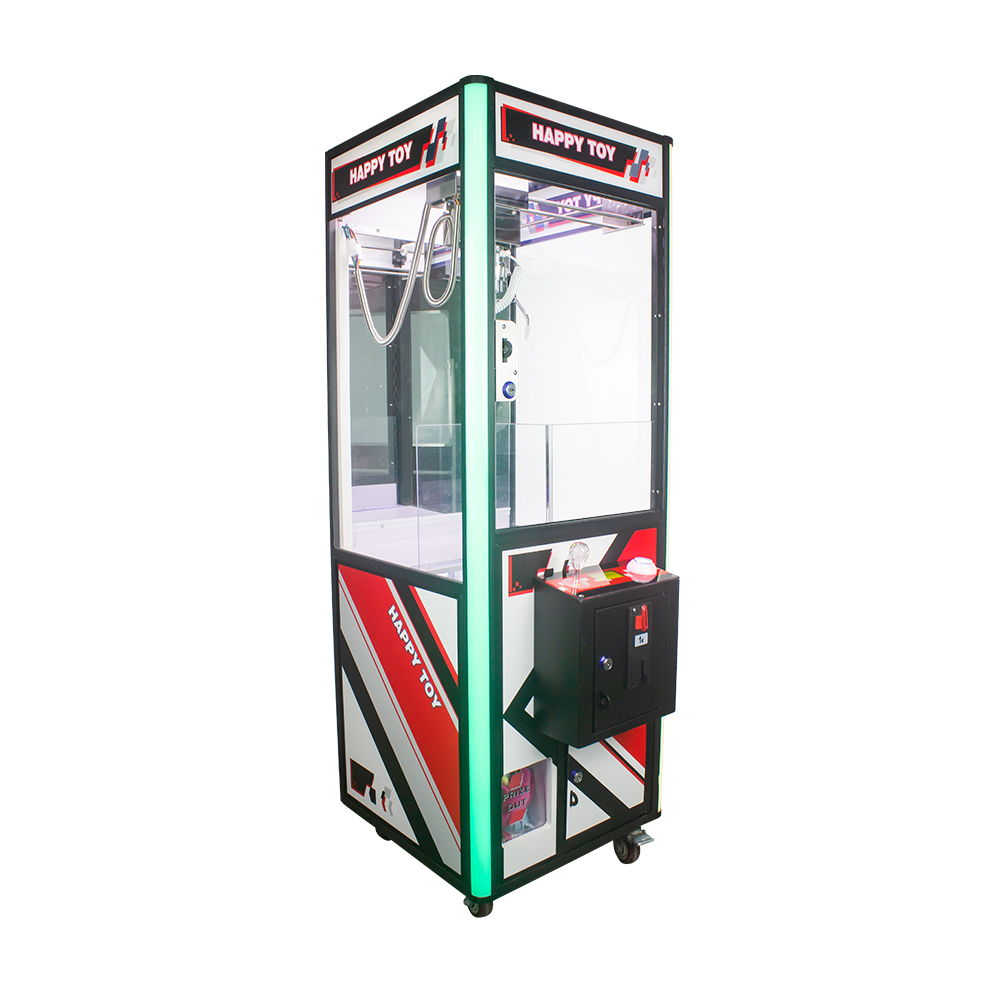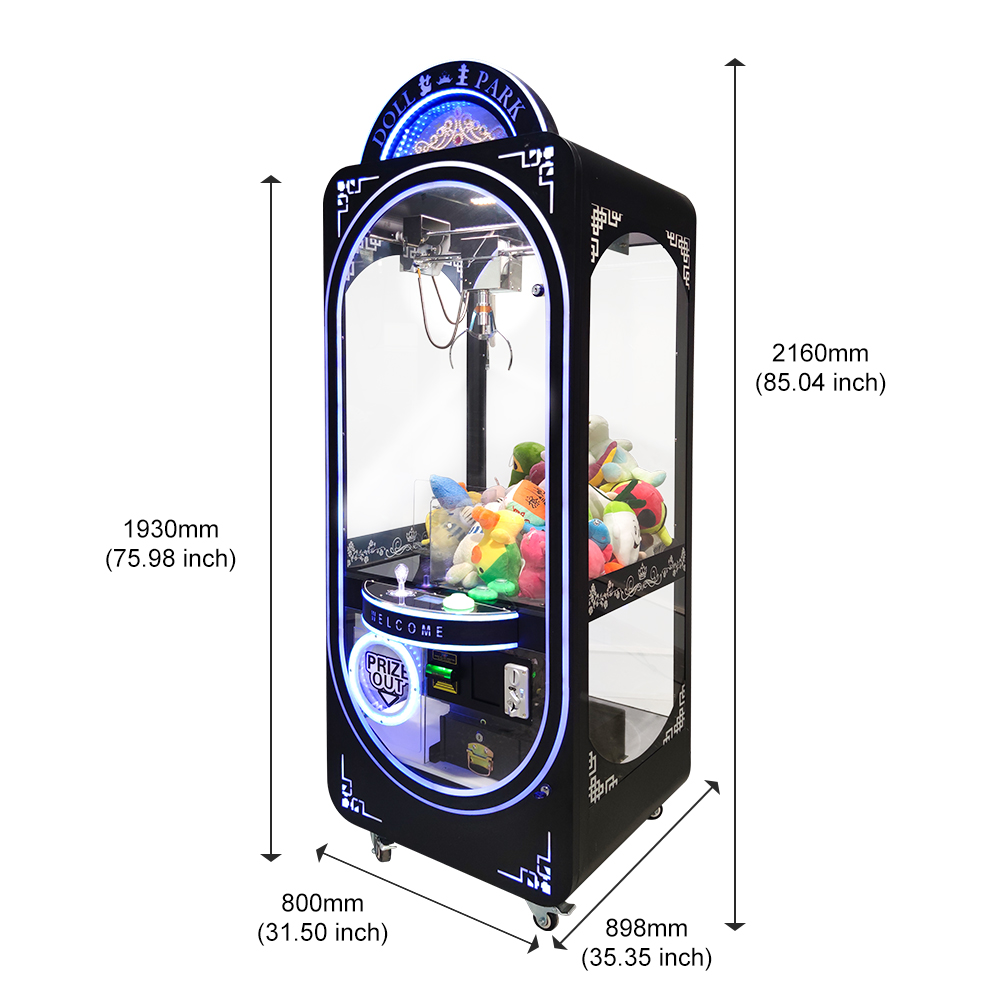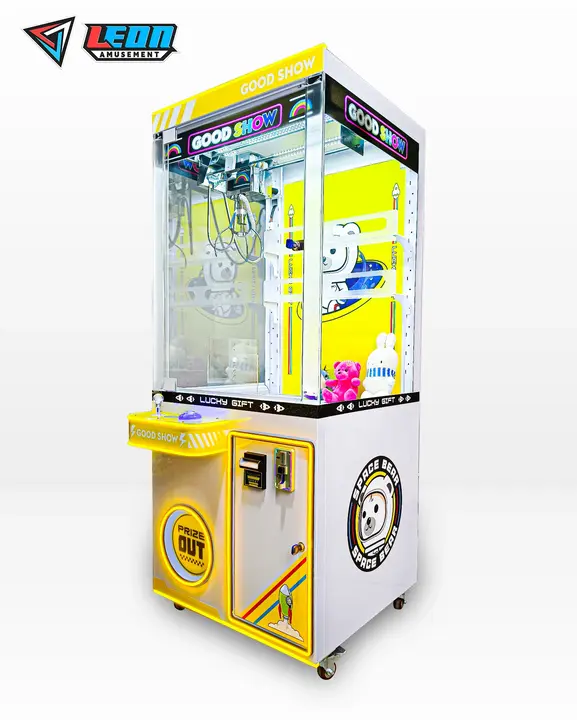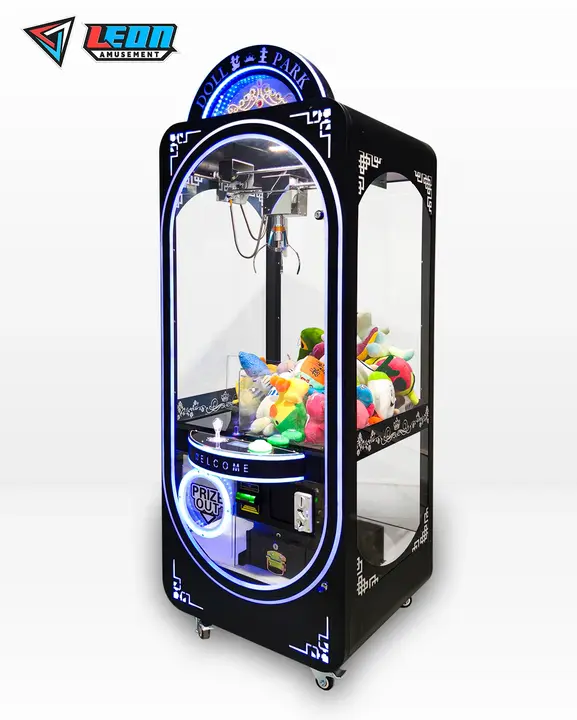Claw machines primarily use steel, acrylic, copper wiring, PVC, and LED lights, ensuring durability, visibility, and engaging gameplay.
Table of Contents
ToggleFrame and Body Materials
The frame and body structure of a claw machine are critical not only to its durability, but also to its functionality and aesthetics. The materials chosen for these components, the flow of raw materials, stability, and overall experience.
Durable Pillars
The internal frame is primarily made of steel because of its high strength and sturdiness. This allows the claw machine to withstand the rigors of repeated play, as well as the physical shuffling that naturally occurs in a busy playground. Typically, the steel frame is 2mm thick, providing a sturdy foundation that won’t deform or dent.
Lightweight and Rust-resistant
Aluminum is often used for exterior panels and structural elements where weight is a consideration. Compared to steel, aluminum alloys are lighter, which makes the machine easier to transport and install. In addition, aluminum won’t rust, which is an important advantage for machines in high humidity areas or those that are regularly cleaned with liquid disinfectants.
Visibility and Safety
The transparent panels of claw machines are usually acrylic because it is clear and safe. Display Area – Made of Clear Acrylic Acrylic is shatterproof and transparent, and can be used to display prizes, so they are both practical and beautiful. Most of these panels are 5mm thick, which strikes a good balance between durability and aesthetics to players.
Design Versatility
Most of the machine’s casing and various small parts are made of ABS plastic. This material is popular for its excellent impact resistance and very easy manufacturing. They allow for complex molds to be made for custom designs and give claw machines an attractive look in different colors.
Enhanced Stability and Reduced Noise
Strategically placed rubber or foam pads help minimize the vibrations and noise generated when the machine is in operation. This substance is usually located underneath the machine or in the middle of the moving parts to keep the customer experience improved and away from the operating sounds, which can often be very annoying in calm situations.

Types of Metals for the Claw
Choosing the right metal for your claw machine’s claws is important for them to work well, last long, and remain safe. This is because metals have varying strengths, flexibilities, and aesthetics. The table above details the role and benefits of each common metal used in claw construction.
Durable Choice
Stainless steel is the most commonly used metal for claws due to its excellent durability. You’ll be using this knife often, and in a variety of extreme environments (likely), so it’s vital that your Tortoise maintains its integrity and beauty even after so many inevitable days and nights outdoors. Most of the time, stainless steel claws are made from 304 grade stainless steel, which is used in manufacturing due to its strength and resistance to rust.
High Strength and High Flexibility
Claws may also be made from carbon steel, which is an effective way to gain a significant increase in strength without sacrificing any desired flexibility. Aluminum has a slightly higher tendency to corrode than stainless steel, but is often used due to its high tensile strength, which is important to prevent prizes from coming loose. Carbon steel claws are often coated to extend their life and performance.
Lightweight and Cost-Effective
Mainly used in claw machines and other low-weight, low-cost applications, aluminum arms are very popular. Aluminum isn’t as strong as steel, but it can support the weight of lighter, smaller machines that are built to cater to lighter prizes. It’s also sought after for its non-magnetic properties, making it less likely to interfere with any electronics within the machine.Excellent brass combination. Brass valves look the best and operate the easiest.
Attractive and smooth operation
Brass is occasionally used in claws where aesthetics are more important, such as boutique or premium claw machines. Brass has a shiny, eye-catching finish that enhances the visual appeal of the machine. Additionally, brass has a smooth surface that minimizes wear and tear on the claws and prizes.
Glass vs. Acrylic Panels
For the transparent components of claw machines, manufacturers usually choose between glass and acrylic panels. Each material has its own advantages, depending on the specific needs of the machine design and its operating environment.
Clarity and Scratch Resistance
The use of glass has advantages such as high clarity and scratch resistance, which is very suitable for high-end machines that pursue high-end aesthetics. It can provide an excellent view of what is inside, providing players with an enhanced visual experience. Glass: Glass panels are usually tempered to make them stronger and safer. If smashed, they will break into small, round pieces that are unlikely to cause serious injuries. Panels using tempered glass are four to five times more durable than glass.
Lightweight and Impact Resistant
In addition, acrylic is much lighter than glass, which is necessary for better operation and installation, especially in large machines. It has stronger impact resistance than standard glass, which means it is less likely to shatter when it hits. Acrylic sheets will not shatter on impact like ordinary glass, so these acrylic sheets (acrylic sheets have a shattering rate of about 17 times that of ordinary glass due to their own superiority) will be ideal for safety in public and crowded places. However, acrylic is more susceptible to scratching than glass, so subsequent visibility may be affected.
Cost Considerations
Acrylic is generally cheaper than tempered glass in terms of cost. This is why it is the preferred choice for claw machine owners who need to balance the price of wire ropes with the durability and security that wire ropes provide.
Maintenance and Lifespan
Glass panels by their nature do not require frequent cleaning to remain social, while acrylic may require constant polishing to remove scratches and maintain social clarity. The choice of glass vs. acrylic often comes down to which is worse: thick glass that resists scratches and looks great, or premium acrylic that is easy to install, will not shatter on impact, but may receive minor scratches before or during installation.
Wiring and Electrical Components
All claw machines have wiring, which is basically the lifeline of any claw machine as it receives the power correctly and safely and distributes it to the right parts of the machine. The design of these systems should ensure the functionality and safety of the machine, and the choice of materials and design are crucial to both of them.
High-quality copper wire
Copper is the most popular material used for wiring due to its high conductivity. It basically reduces the energy loss when transmitting electricity. The copper wire of most claw machines is made of AWG (American Wire Gauge) 18 or 20, and with this wire, you can get a good balance between flexibility, bearing, durability, and conductivity. This is the gauge that protects the claw machine from burning up under load with typical power.
Insulation
The insulation around the copper wire is as important as any other insulation. PVC (Polyvinyl Chloride) is widely used for its durability and electrical insulation benefits. The wires are then covered with PVC, not only to protect them from abrasion or outdoor conditions, but mainly to make the machine work safely. Insulation Thickness: The thickness ranges from 0.75 to 1.5 mm, which is enough to protect you from electric shocks and short circuits.
Connectors and Terminals
The electrical connectors and terminals used in claw machines are carefully designed to provide reliable and secure connections. Higher-end models may sometimes use gold-plated connectors to help prevent corrosion and extend the life of the cables. These edges are critical to ensuring contact with various electronic boards, such as the motherboard, power supply, and motors.
Control Systems
Claw machine control systems typically include a central processing unit (CPU) that handles the operation of the machine. Such CPUs are used to control the movement of the claws, timing mechanisms, and scoring in games. They are paired with custom software that can be updated to change game dynamics or correct errors.

Decorative and Finish Materials
The aesthetics of a claw machine can significantly impact its popularity and usage. Decorative and finishing materials not only add visual interest, but also protect the machine from environmental factors and wear and tear. Below is a detailed look at the materials used to enhance the appearance and durability of claw machines.
Vinyl Wraps
Vinyl wraps are widely used to decorate the exterior of claw machines. These wraps can be customized with a variety of designs, from vivid graphics and popular characters to sleek, modern aesthetics. In addition to their aesthetics, the vinyl acts as a protective layer, protecting the machine from scratches and minor impacts. These wraps are typically 2 to 3 mils (thousandths of an inch) thick, providing a durable yet flexible covering that can last up to five years under normal arcade conditions.
Powder Coating
For metal parts, powder coating is a preferred finishing method. The technique involves applying a dry powder that is then cured under heat to form a skin-like layer. It is more environmentally friendly than traditional paint, does not emit volatile organic compounds (VOCs), and has a surface that is less susceptible to chipping, fading, and wear. Powder coating comes in a variety of colors and textures, allowing for full customization to the theme of the machine.
LED Lighting
LED lighting is an integral part of the appeal of modern claw machines, illuminating the interior and engaging players. Not only are these lights energy efficient, they are also capable of displaying a variety of colors and can be programmed to change patterns or respond to game events. LEDs typically have a lifespan of up to 50,000 hours, ensuring they can illuminate the claw machine for years without needing to be replaced.
Acrylic Decorations
For machines seeking a more sophisticated look, acrylic decorations can be used to provide a glass-like finish that is both beautiful and functional. These decorations can be molded into complex shapes, providing clear views and a sleek appearance. The use of acrylic also increases the overall durability of the machine as it prevents cracking and yellowing over time.



